- Stack’s Lowest Price Ever for 10TB of Cloud Storage PCMag
- Keep 10TB of files private for life for A$421 with Internxt Cloud Storage Mashable
- This Lifetime 10TB Cloud Storage Plan Just Got a Deal Days Price Cut extremetech.com
- A Dropbox alternative for just $280 — a 10TB lifetime subscription Mashable
Category: 4. Technology
-
Stack's Lowest Price Ever for 10TB of Cloud Storage – PCMag
-
I Cracked Open a Can of Purified Water and Went 'Fission' With Fallout 76's Devs – PCMag
- I Cracked Open a Can of Purified Water and Went ‘Fission’ With Fallout 76’s Devs PCMag
- Fallout 76: Roadmap for 2020 brings 3 seasons & Brotherhood of Steel Mein-MMO
- Fallout 76 says: “Seasons are free” – Confused players are relieved Mein-MMO
- Fallout 76 will show future at huge event – Withdraws at the last minute Mein-MMO
- Fallout 76 developed well in 2020 – What comes next in 2021? Mein-MMO
Continue Reading
-

Compete for Glory and Legendary Rewards — Diablo Immortal — Blizzard News
Come forth protectors of Sharval! From July 7–23, 3 a.m. server time, the Diablo Immortal Druid Trial Race is your chance to show your devotion to Sanctuary in a fierce, time-based dungeon challenge.
Players who accept the challenge from the in-game event hub must run a hellish version of Mad King’s Breach while playing as the Druid. Your goal? Cut through hordes of the Burning Hell’s foot soldiers and their deranged king as quickly as possible. You will be ranked based on your fastest clear time, with ties decided by highest damage output in that run.
Each week of the competition, the top 200 players from each server will receive one random Legendary item and one random Set item delivered via in-game mail. And once the competition ends, the mightiest Druid—the number one ranked player worldwide—will assist in naming a future Legendary item.
Attune to nature’s might, center your primal sensibilities, and enter the fray. May success find you!
See the current leaderboard rankings on the official Diablo X account. They will be updated every Monday and Thursday at 7 p.m. PDT.
To get a full overview of the Druid ahead of the race, including its skills and affixes, visit this article.
[Terms and Conditions]Continue Reading
-
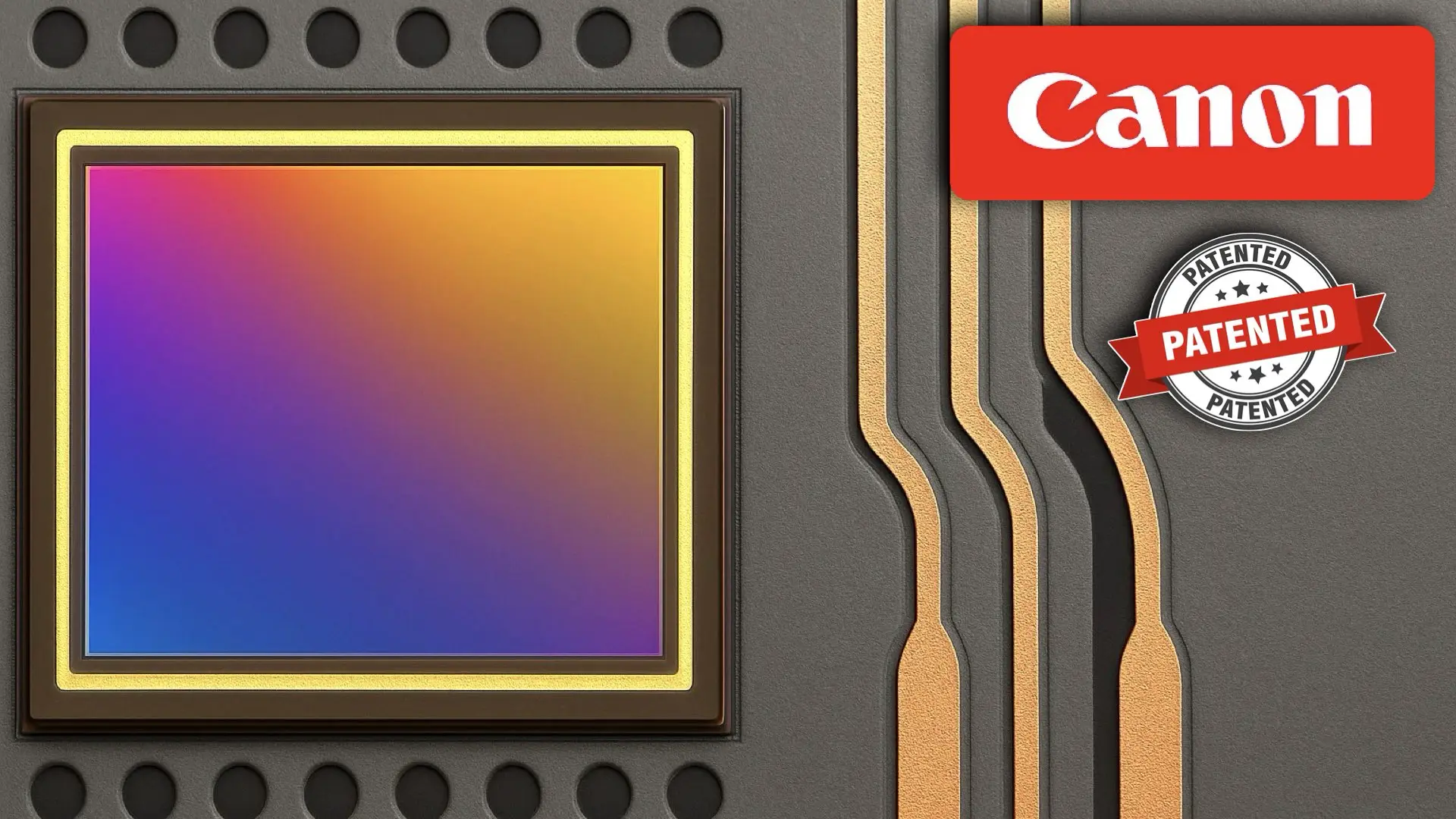
Canon Patent Reveals Smarter Wiring Design for Large Image Sensors
In a bid to advance large-format imaging, Canon has just patented a new semiconductor wiring structure that could improve the performance, reliability, and production yield of high-resolution sensors. It’s more than smaller and smarter wires. Think of it like a more efficient and robust design for large image sensors. Check out the highlights below.
Canon new patent: Semiconductor Device And Method For Manufacturing Semiconductor Device Modern image sensors, especially full-frame and larger formats used in cinema and photography, require extremely fine electrical wiring to connect pixels across the chip. But as sensors get physically bigger (sometimes over 36mm wide) conventional lithography equipment hits a hard limit: it simply can’t expose the entire sensor area in one shot. That’s where Canon’s innovation steps in. Canon’s new patent outlines a way to strategically widen wiring segments in overlap regions: those areas where two photomask exposures meet on a large wafer. By increasing the width of these “bridging” sections while keeping the rest of the wiring narrow (less than 180 nanometers), Canon can dramatically reduce risks of:
-
Misalignment between exposure zones
-
Broken or short-circuited signal lines
-
Noise and image artifacts, especially near pixel rows
This architecture uses damascene wiring which is a process where trenches are carved into an insulating layer, filled with copper, and polished flat. It’s the gold standard for modern CMOS imaging sensors.
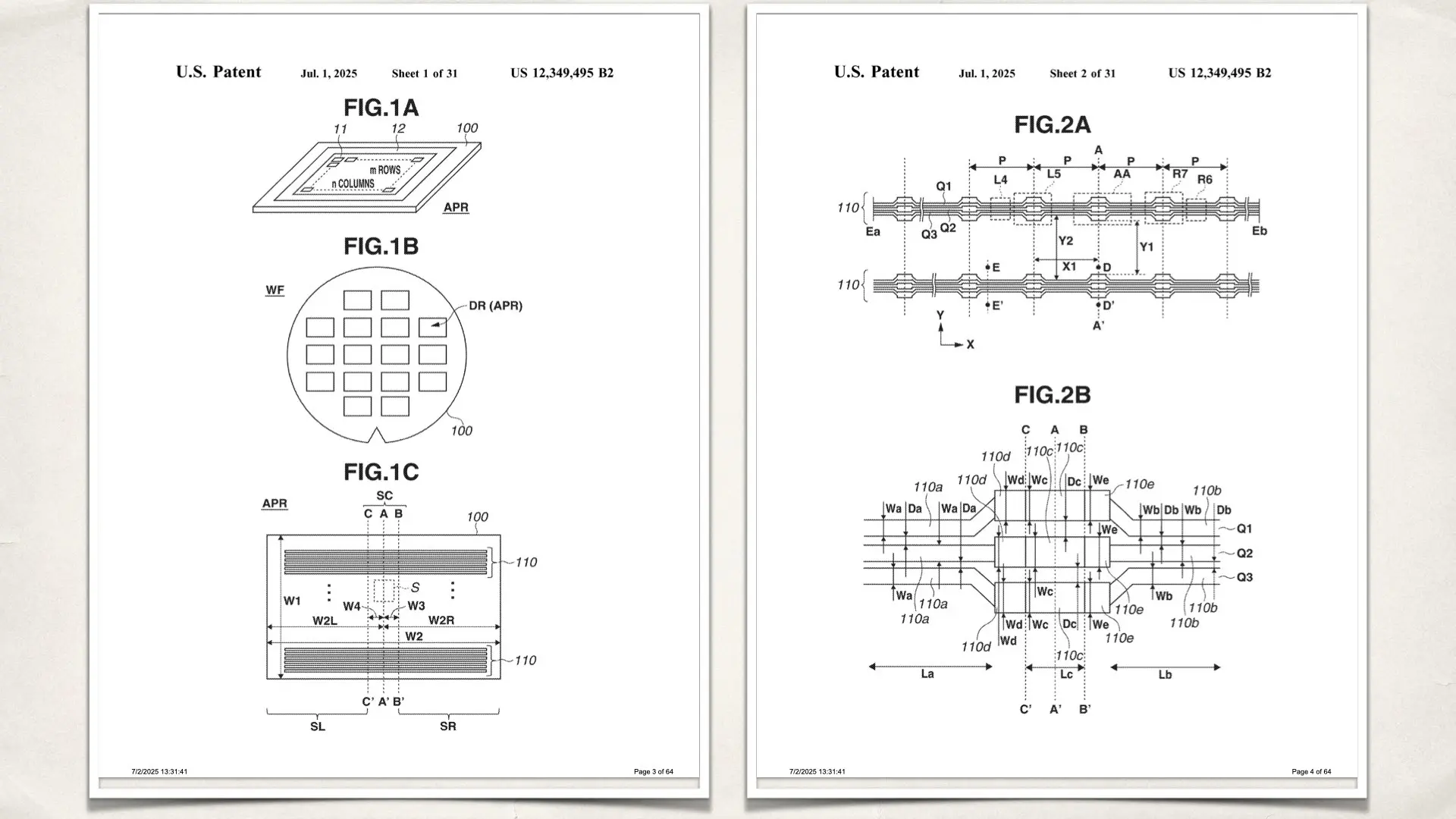

Canon new patent: Semiconductor Device And Method For Manufacturing Semiconductor Device 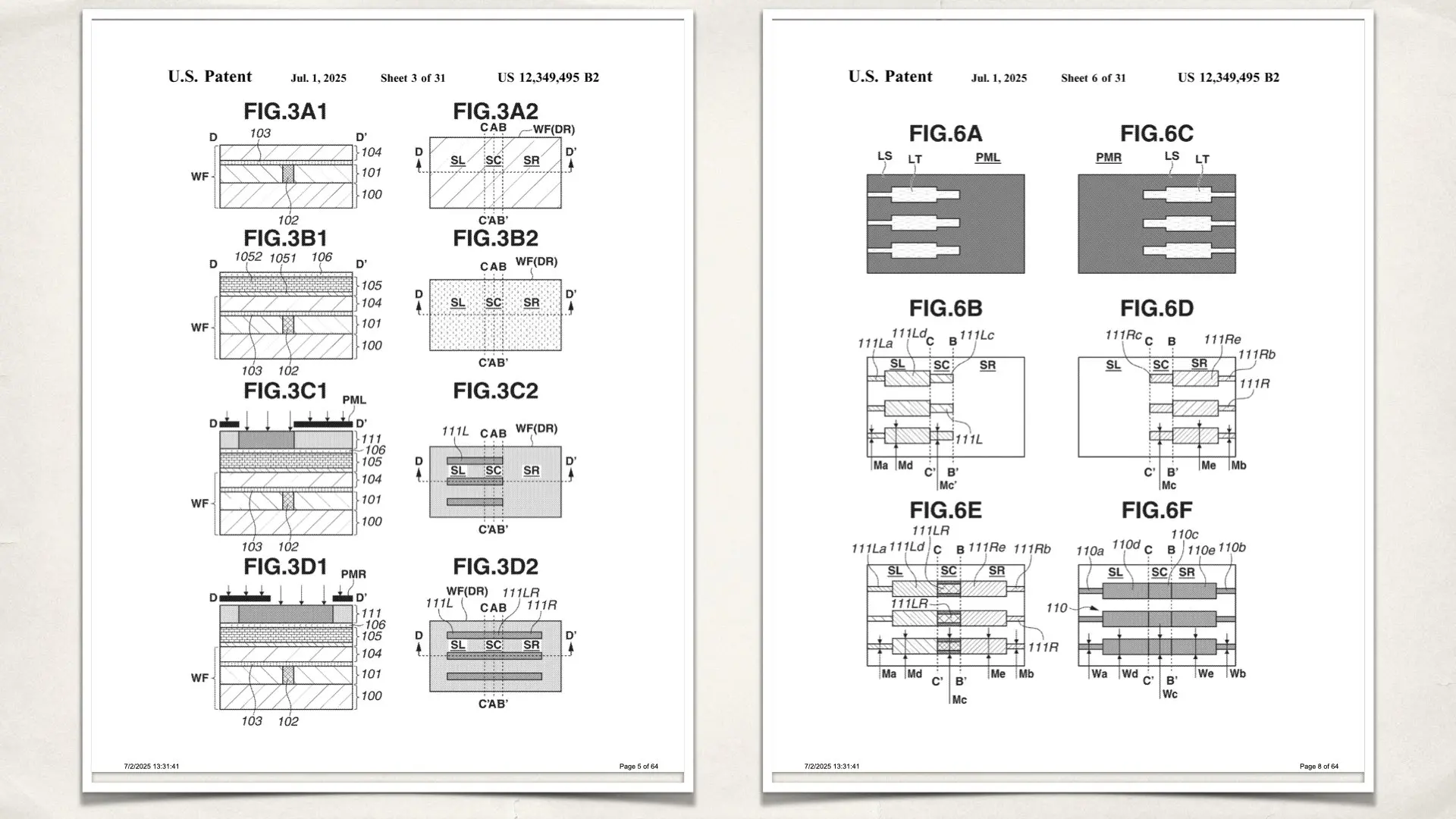

Canon new patent: Semiconductor Device And Method For Manufacturing Semiconductor Device In practice, this innovation enables Canon to:
-
Build larger and more reliable CMOS sensors without compromising pixel density
-
Deliver cleaner signals from edge to edge, especially important in 8K+ resolution sensors
-
Improve manufacturing yields, which helps lower costs in production
The patent also integrates a clever pixel layout trick: thickened wiring segments are mirrored even in pixels that don’t lie in exposure overlap regions. This helps maintain uniform image quality and avoids visible artifacts in the final image. Whether Canon will apply this to upcoming Cinema EOS, RF mirrorless, or even industrial sensors, is not stated. But from a tech perspective, it’s a smart move toward future-proofing high-resolution imaging.
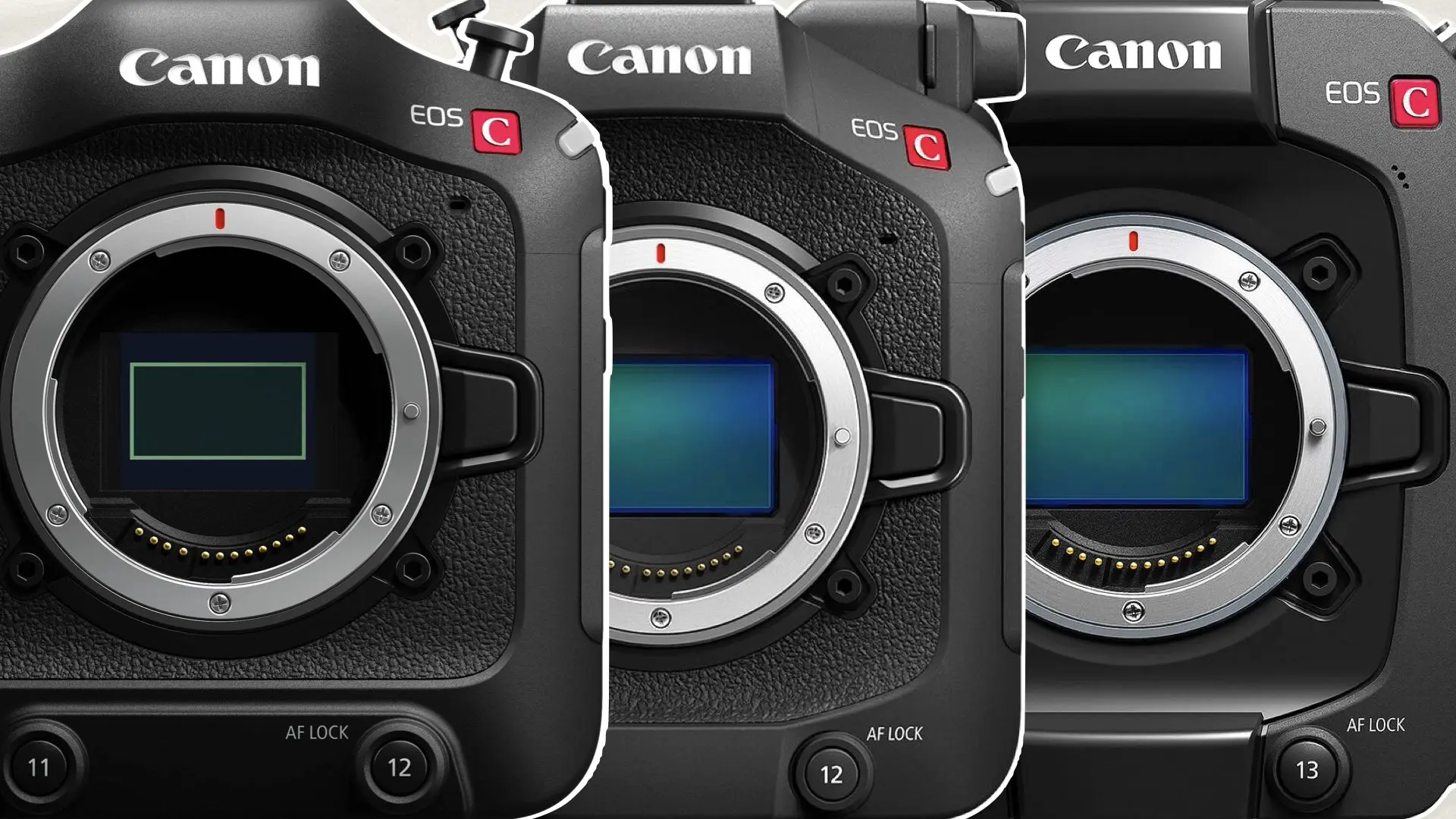

Canon EOS C70 vs EOS C80 vs EOS C400: Which Cinema Camera Matches Your Shooting Style? What makes this patent stand out is not flashy resolution numbers or marketing jargon, but rather the underlying infrastructure that enables Canon to scale up its sensors safely and efficiently. As demands rise for larger sensors, whether in cinema, surveillance, or computational imaging, this kind of semiconductor engineering is what keeps innovation possible. Hence, Canon’s latest patent is a great example of subtle but essential sensor design thinking. By tweaking how wires are routed across large chips, Canon is laying the groundwork for more powerful and reliable large sensor cameras in the years ahead.
Canon Store and Products


Continue Reading
-
-
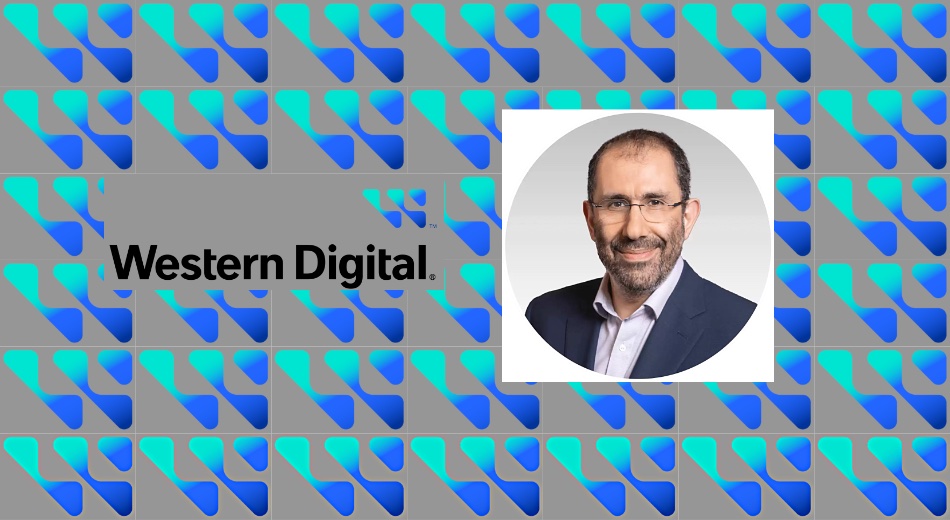
Western Digital sees HAMR capacity advantage over Seagate – Blocks and Files
Interview: We had the opportunity to speak with Ahmed Shihab, Western Digital chief product and engineering officer, and he told us that WD’s HAMR tech is progressing well, that OptiNAND can provide a capacity advantage, and that the company has a way to increase the bandwidth per terabyte of disk drives.
Shihab joined Western Digital in March, following more than a year as a corporate VP for Microsoft Azure storage and eight years as AWS VP for Infrastructure hardware. Azure and AWS will be two of the largest hyperscaler buyers for nearline disk drive storage, which is WD’s biggest market. Shihab will have detailed knowledge of how these hyperscalers evaluate disk drive product transitions and what they look out for, invaluable to Western Digital as it follows Seagate with its own HAMR technology transition. It will not want to endure Seagate’s multi-year HAMR drive qualification saga.
Blocks & Files: Could you start by talking about the state of Western Digital and HAMR, how that’s going?
Ahmed Shihab: Actually, I was a little afraid when I first came in. It’s like, what will I find? But I was really happy with what I found because actually HAMR technology works. That’s the good news. Obviously there’s a lot of work to do to get it to the reliability levels and density levels and things like that. So there’s a lot of engineering work. So the physics, we got that done. The basics in terms of the media and the heads and all the recording technology, we got that done. There is a bunch of manufacturing stuff we have to get done to dial everything in. You know how that works. A new technology; you’ve got to do some cleanup from the initial concept.

Ahmed Shihab We have a couple of customers helping us out. So that was always very gratifying. They’re looking at the drives, they’re giving us a bunch of feedback.
One of the lessons we learned is engage your customers early and being a former customer, I really appreciate that because I always wanted to know how. I don’t want to be surprised by the end of the day when somebody comes to me and says, well, here’s our technology now could you start using it? It takes a long time to qualify. So in one of my prior roles, we always engaged early. I encourage my team to engage early with technology so that we can get on the leading edge of its release and that’s what we’re doing.
Blocks & Files: Do you anticipate that the qualification period with hyperscaler customers for HAMR will be as long as the one Seagate has been enduring?
Ahmed Shihab: I hope not. The thing is there’s an advantage to being a fast follow-up because, if you think about it, AWS was always a fast follow-up for a long time and it did us well. We didn’t start leading until the 2017, 2018 sort of time frame and that is a very good philosophy in the sense a lot of the lessons were already learned. Customers will tell us what to expect and what works and what doesn’t. And we’ve certainly benefited from that experience. So that’s one of the things that’s really helping us accelerate that. And we have been working on HAMR for a long time. The ecosystems were mature. We had developed the technology. It wasn’t as much of a focus because we had the density of roadmap in ePMR, which is also unique to us. That takes us into the high thirties, early forties (TB). So we needed to accelerate it. That’s what we’re doing now.
Blocks & Files: Do you think that with an 11-platter technology you have more headroom for HAMR development? It’s less rigorous than for Seagate with its 10-platter technology to match any particular capacity point.
Ahmed Shihab: It certainly gives us more headroom to play with. We can use the extra platter to give us the overall capacity at lower density. So it gives us more headroom. It means we can go to market faster than they can. It’s not a trivial thing to do, obviously, to operate on 11 versus 10. It sounds easy, but all the tolerances, I’m sure you can appreciate, get tight. So we think that is an advantage and we’re certainly taking advantage of it.
Blocks & Files: Will you use what I understand to be the same tactic as Seagate, which is provide lower capacity drives by just stripping out platters and heads and basically using the same HAMR technology, manufacturing for everything?
Ahmed Shihab: I think in time, maybe. Right now we don’t need to. Our ePMR technology is mature, it works, it’s high yield, it’s good margins with the OptiNAND and everything else we’re doing. We can actually continue to deliver that technology for some years.
Blocks & Files: Will OptiNAND give you particular opportunities with HAMR drives that don’t accrue to Seagate or Toshiba?
Ahmed Shihab: Let’s look at what OptiNAND does. UltraSMR (shingling) is what really is enabled by OptiNAND and UltraSMR is an algorithmic gain of capacity. Because of OptiNAND, we can actually get more capacity per platter than our competition can. So it’s an algorithmic thing that translates across the technologies. We expect it to apply equally to HAMR. We’re probably going to be a little less aggressive in the beginning, but it has the headroom, and it’s already implemented in the drives because we take technology from PMR to HAMR. It’s just the recording technology that’s different.
Blocks & Files: Does OptiNAND mean that, again, you’ve got a little bit more headroom with HAMR density than you would without it?
Ahmed Shihab: Yes. So one of the things we want to do is to be able to return that capacity to customers and in the beginning you’ll probably see us being a little conservative. We generally are more conservative. Our roots, we came from IBM and HGST and places like that where we are very, how shall I put this? We’re not flamboyant. We always deliver what we say we’ll deliver. As a customer, I’ll give you an example. We had HGST and IBM and WD drives that lasted way, way longer and with less failure rates than the competition. So we’ve always been appreciative of that and that is part of our culture.
We’re not flamboyant. We’re going to go on with it. We’re going to match and exceed Seagate’s capacity because we can win with things like OptiNAND that all our customers have qualified. They have qualified UltraSMR on ePMR. That’s already qualified in their software and we don’t have to do anything different when they come to the new drives with HAMR in them. They’ll qualify them for physical vibrations, all the usual things we help them with. But beyond that, there’s no new software they have to create.
Blocks & Files: How do you see the disk drive market developing?
Ahmed Shihab: One of the things I would say from being a customer is this: disk drives are really the bedrock of all the data economy that’s been developed. Data is constant. If you think about the cloud players’ object store, S3 and Blob stores, and all this data is constantly moving around, moving up and down the tiers, it’s moving to different regions, and moving for maintenance purposes. It’s all transparent to the user. Nobody sees it. You just apply a policy. You might have a trillion objects but it’s one policy and in the background all this data is moving around and being scrubbed and checked for bit rot and things like that.
It’s a very active environment in the background. So this is where we feel that disk drives have stood the test of time because they can deal with the read write endurance, the performance, the bandwidth – performance per terabyte is actually really more important than the IOPS in this space because it’s mostly large objects or large chunks that are moving around. So we see that as continuing. Disk drives are going to continue to be very relevant. There’s some Google papers and there’s a couple of quotes from a distinguished engineer now at Microsoft talking about how important disk drives are and continue to be important for the world. SSDs have their place, they absolutely have their place, and it’s more a question of better together than one versus the other.
Blocks & Files: How about for video surveillance, smaller network attached storage drives and that kind of thing?
Ahmed Shihab: If you think about video surveillance, it’s a very write-intensive workload. The endurance is a big deal and it’s also a very cost-sensitive world. So being 6x cheaper than QLC NAND and having practically infinite endurance, it makes a perfect sense for disk drives to be in that world. That’s definitely what we continue to see in that workload. SSDs tend to do well in very small block-based use cases and in caching use cases and high intensity read use cases.
Blocks & Files: Do you think HDDs will continue to play a role in gaming systems?
Ahmed Shihab: In some, I would say yes. It’s hard to say. The gaming market changes quite quickly. I don’t really have an opinion just yet on that one.
Blocks & Files: Disk drives are pretty much in a fixed format; it’s a 3.5-inch drive bay. And that format has a long life ahead of it because you continually are going to be able to increase capacity. And so the cost per terabyte will continue to slowly edge down and your customers will get more value from disk drives than they can get from any alternate technology, whether it be SSDs above them in the performance space or tape drives below them. Is that pretty much it?
Ahmed Shihab: We actually tried to look at five and a quarter inch drives, things like that. But the three and a half inch, one inch high form factor has really endured; mostly because you have existing infrastructure, you have people who know how to handle it. There’s a whole bunch of operational considerations to do with it. And it wasn’t lack of trying for wanting to change it, but there are practical limitations to do with the rate of spin and the size of the platters and the mechanics about the platters and the vibrations and things like that. So it’s here to stay in my opinion.
The nice thing is we actually know the physics of the recording technology of HAMR is going to take us for another at least 10, 15, 20 years. There is a whole roadmap ahead of us in that world and that’ll continue to deliver the dollars per terabyte that customers want. And there’s opportunities for us to invent new capabilities. One of the things that we’re very excited about is something new about how we managed to increase the bandwidth per terabyte. So I’m not going to say much more about it, I’m just going to tease it out there. We talked about it publicly also, but it’s something that we’re very excited about.
Blocks & Files: Do you think there’s a future for NVMe access drives?
Ahmed Shihab: The only reason I can think is NVMe will become important is when the bandwidth exceeds the capability of SATA. I think it’s going to be a practical thing that changes it. There’s a lot of ideological conversations around NVMe versus SATA versus SAS and, as a company and as a team, we’re very rooted in pragmatism. If there’s no need for it, don’t do it, because it’s disruptive to customers. And that’s something we’re very careful about, in the sense we want to reduce the friction that customers feel when they’re adopting new technology.
If you think about SMR and what we’ve done with OptiNAND and things like that, we learned a bunch of lessons from that, which is how to make it really super low-friction for customers to get into new drive technology. And we’ve been working with customers for a long time helping them write code, deliver libraries so that they can take better advantage of all the capabilities of drives. So we very much want to work in lockstep with those customers.
So just changing the interface for the sake of it; can we do it? Of course we can do it. Doing NVMe now is not really hard. It’s changing the wire and the protocol. It’s not a big deal. The question is, is the market, our customers, ready for it? Is it necessary? And customers will only do it when it’s necessary.
Continue Reading
-
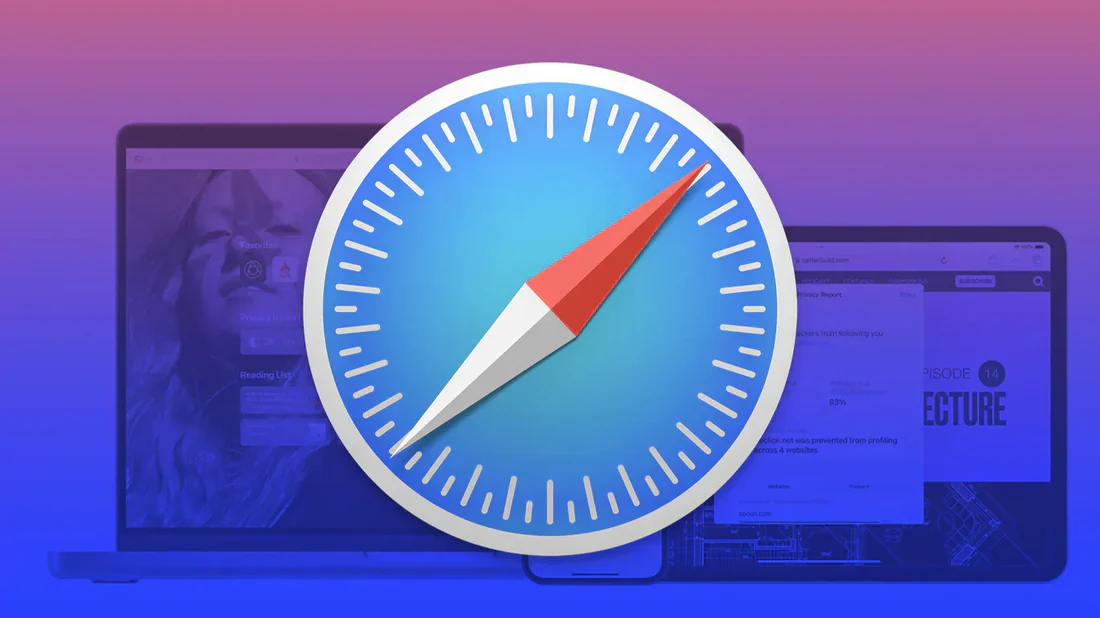
Tech Preview 222 Released With Fixes
A new version of Apple’s experimental Safari Technology Preview browser has been released. The browser, which was first released in 2016, allows users to test features that will be included in later Safari editions. Version 222 of the Apple Safari browser update brings a number of compatibility and performance enhancements. Notably, improvements focus on topics including the Web API, accessibility, CSS, media, rendering, and scrolling. The purpose of these modifications is to increase browser dependability and get features ready for future mainstream Safari releases.
At the moment, macOS Sequoia and macOS Tahoe are compatible with Safari Technology Preview 222. These are the most recent macOS versions from Apple, which should be released later this year. As a result, the upgraded experimental browser is immediately useful for those using more recent versions of macOS.

The Apple Safari browser update can be found under Software Update in System Preferences or System Settings. The updated version will only be visible to people who have already downloaded the browser from Apple’s website. Apple has posted release notes on its Safari Technology Preview website with all the information.
Despite being designed for developers, this version can be used without an Apple developer account. Furthermore, there are no system problems when using the preview version in conjunction with the standard Safari browser. With this release, Apple keeps gathering user and developer input to improve Safari’s essential functionalities.
Continue Reading
-

Unleashing Brand-New AI Noise Suppression and Crystal-Clear 4K/60fps Screen Recording
AI Audio Suppression
Digiarty has officially launched Macxvideo AI V3.5, which brings powerful new features—including AI-powered noise suppression and 4K/60fps screen recording.
CHENGDU, SICHUAN, CHINA, July 2, 2025 /EINPresswire.com/ — Digiarty Software, a leading innovator in AI-powered multimedia solutions, today announced the release of Macxvideo AI V3.5, marking the first major update since its groundbreaking May 2025 launch. Building on the success of its initial release, this update introduces transformative AI Audio Suppression for pristine audio clarity, advanced 4K 60fps screen recording capabilities, and key performance enhancements, positioning Macxvideo AI as an all-in-one powerhouse for creators, educators, and professionals.
For more details, please visit: https://www.macxdvd.com/macxvideo-ai/free-update.htm?ttref=2507-wbd-mxv-bl-enpr
In today’s digital-first world, users increasingly demand studio-quality audio and smooth, high-resolution screen captures — capabilities previously out of reach for many without complex tools or high-end systems. Version 3.5 directly addresses the long-standing pain points in content production —strategically front-loaded with its two most impactful upgrades — AI Noise Suppression and 4K 60fps screen recording. This approach not only highlights the agility and responsiveness of Macxvideo AI to market demands and user needs but also sets high expectations for the product’s future trajectory. Below are the new features and key enhancements.
Key Upgrades in Version 3.5 Include:
1. Introducing AI-Powered Noise Suppression (New):
Macxvideo AI V3.5 takes a major leap forward in audio quality with the introduction of AI Noise Suppression, a brand new feature powered by a real-time deep learning architecture. Unlike traditional noise gates dependent on static frequency filters, the system’s neural network models—trained on over millions of audio samples—analyze real-time waveforms to eliminate distractions, from the persistent hums and hisses to keyboard clicks and ambient chatter. It is a game-changer for creators and professionals alike-delivering studio-grade clarity for podcasts, gameplay, online lectures, meetings, and more.2. Professional 4K/60fps Screen Recording (Improved):
Macxvideo AI V3.5 significantly elevates its screen recording capabilities, building upon its robust foundation that already allows users to capture screen, webcam, audio, and even create picture-in-picture videos for diverse scenarios like professional tutorials, immersive gameplay, and seamless online meetings. The new update now introduces robust support for crystal-clear 4K (3840×2160) resolution screen recording, ensuring every pixel is captured with stunning clarity. Complementing this high-resolution capture, the software now supports screen recording at up to 60 frames per second (fps). This makes it perfect for fast-paced content such as gaming walkthroughs, software demos, or action-packed tutorials.3. Other Enhancements in Macxvideo AI V3.5:
• Optimized facial restoration algorithm: The facial restoration algorithm has been further optimized, leading to even more natural and accurate enhancements for faces in low-res or old images.
• Fixed memory leak issue: Resolved a memory leak issue found in the video editing toolbox effects. This critical fix dramatically improves the software’s stability and performance, especially during extended editing sessions.
• Enabled ARM64 of Python: Macxvideo AI now fully supports the ARM64 version of Python. This enhancement provides superior compatibility and optimized performance specifically for users operating on modern Apple Silicon Macs. By natively leveraging the power of M-series chips, the app delivers faster AI processing and improved overall responsiveness.Building on a Strong Foundation- A Comprehensive Media Suite
This 3.5 release expands the capabilities introduced in May’s groundbreaking launch, which established Macxvideo AI as a full-featured, AI-powered, and hardware-accelerated toolkit for video and audio processing on macOS. Key features include:
• AI Video Enhancer – Elevate old and low-quality video, remove noise, blur, and compression artifacts, restore clarity, and generate realistic details using advanced AI.
• AI Image Enhancer – Upscale blurry photos and AI-generated images to 4K/8K/10K, enhance sharpness, restore facial features, and colorize black-and-white images.
• Versatile Video Converter – Support 420+ audio and video formats for effortless media conversion across devices and platforms.
• High-Efficiency Compressor – Reduces file sizes by up to 90% while preserving visual quality, ideal for storage, uploading, and sharing.
• Built-in Video Editor – Offer precise tools for cutting, trimming, merging, splitting, rotating, applying visual effects, and more.
These core features make Macxvideo AI an all-in-one creative solution tailored to the needs of modern Mac users.“V3.5 marks a major milestone in our journey,” said Jack Han, CEO of Digiarty Software. “It builds on our strong foundation of AI-powered enhancement with targeted upgrades that solve real problems — from eliminating background noise to delivering smooth 4K screen captures — all while staying fast, smart, and Mac-native.”
Pricing and Availability
Macxvideo AI V3.5 is available now for download on the official website https://www.macxdvd.com/macxvideo-ai/?ttref=2507-wbd-mxv-bl-enpr. Despite the major upgrade, pricing remains unchanged: $25.95/year, or $45.95 for the lifetime plan which includes lifetime free updates and access to the latest AI features. Purchase options are available at: https://www.macxdvd.com/macxvideo-ai/buy.htm?ttref=2507-wbd-mxv-bl-enprAbout MacXDVD
Founded in 2010, MacXDVD Software is a leading provider of multimedia software. With a focus on innovation and user satisfaction, MacXDVD has developed a comprehensive suite of high-quality tools for DVD ripping, video enhancing, conversion, media management, and more—designed specifically for the macOS platform.About Digiarty Software
Digiarty Software, the developer of MacXDVD, WinXDVD, VideoProc, and Aiarty, is a leading provider of multimedia software solutions for over 19 years. Renowned for their unwavering commitment to quality, performance, and customer satisfaction, Digiarty boasts a diverse software suite encompassing DVD backup, iPhone management, video transcoding, editing, and more. The comprehensive offering has garnered over 256 million software installations across 180 countries. To get more info about the company, please visit its official web page: https://www.macxdvd.com/.WANG LI
Digiarty Software
+ +86 134 3847 4002
email us here
Visit us on social media:
Facebook
YouTube
XLegal Disclaimer:
EIN Presswire provides this news content “as is” without warranty of any kind. We do not accept any responsibility or liability
for the accuracy, content, images, videos, licenses, completeness, legality, or reliability of the information contained in this
article. If you have any complaints or copyright issues related to this article, kindly contact the author above.
Continue Reading
-

VS Code’s Open Source AI Revolution: A New Chapter for Developers
The development landscape has just undergone a dramatic shift. Microsoft’s VS Code team has taken a bold step toward democratizing AI-powered coding by open-sourcing its GitHub Copilot Chat extension under the MIT license. This milestone represents more than just another code release; it’s a fundamental reimagining of how AI tools should be developed and deployed in the developer ecosystem.
Breaking Down Barriers to Innovation
The decision to make VS Code an open-source AI editor addresses a growing concern in the developer community: The black-box nature of AI coding assistants. Until now, developers have been using powerful AI tools without understanding their inner workings, from prompt engineering techniques to context handling strategies. This transparency gap has hindered innovation, making it challenging for developers to fully optimize their AI-assisted workflows.
By open-sourcing the Copilot Chat extension, Microsoft has lifted the veil on these critical components. Developers can now examine exactly how agent mode functions, understand what context gets sent to large language models and study the prompt engineering strategies that make these tools effective. This level of transparency transforms AI coding from a mysterious process into something developers can understand, modify, and improve.
Community-Driven AI Development
The open source approach leverages the same community dynamics that made VS Code itself a success. Over the past decade, VS Code has evolved from a Microsoft project into a community-driven platform, with thousands of extensions and contributions from developers worldwide. Now, the VS Code team is applying this proven model to AI functionality.
This community-centric approach promises to accelerate innovation in ways closed development cannot match. When developers can see precisely how AI features work, they can identify areas for improvement, fix bugs, and adapt functionality to meet specific needs. The collective intelligence of the open-source community often surpasses what any single organization can achieve, regardless of its resources.
Practical Benefits for Development Teams
The immediate practical implications are significant. Development teams can now audit AI functionality to ensure it meets their security and compliance requirements. Organizations with strict data governance policies can examine exactly what information is transmitted to language models and modify their behavior accordingly.
For individual developers, this transparency enables more effective prompt engineering and a better understanding of AI behavior. Instead of treating AI coding assistants as unpredictable tools, developers can study successful patterns and apply them more systematically. The ability to examine system prompts and implementation details provides insights that can improve AI-assisted productivity across entire teams.
“This marks Microsoft’s follow-through to open source GitHub Copilot Chat, announced at Microsoft Build 2025,” said Mitch Ashley, VP practice lead of software lifecycle engineering at The Futurum Group. “GitHub Copilot Chat serves as the direct interface between the developer and the underlying AI code generation and agent capabilities available through VS Code and GitHub Copilot Agent. This transparency helps build trust with developers as AI takes on increased workloads for developers.”Technical Architecture and Integration Strategy
The VS Code team’s technical approach demonstrates thoughtful planning for long-term sustainability. Rather than keeping AI functionality in a separate extension indefinitely, they plan to integrate components directly into VS Code’s core. This integration strategy ensures that AI becomes a first-class citizen in the editor, rather than an afterthought.
The decision to maintain issue tracking in the central VS Code repository further reinforces this integration philosophy. It signals that AI functionality isn’t a side project but a central part of VS Code’s future direction. This architectural approach provides a foundation for more sophisticated AI features while maintaining the editor’s performance and reliability standards.
Industry Implications and Future Outlook
This move represents a broader shift in how technology companies approach AI development. As AI becomes integral to software development workflows, the traditional closed-source model creates dependencies that many organizations find uncomfortable. Microsoft’s decision to embrace transparency could pressure other AI tool providers to follow suit.
The implications extend beyond individual developer productivity. Educational institutions can now use real AI implementations to teach prompt engineering and AI integration techniques. Researchers gain access to production-quality AI coding systems for academic study. Security researchers can audit AI tools for potential vulnerabilities or biases.
Challenges and Considerations
Open-sourcing AI functionality presents its challenges. The VS Code team must strike a balance between transparency, performance optimization and consistency in user experience. Managing community contributions while maintaining code quality requires significant investment in review processes and documentation.
The partial approach, open-sourcing chat functionality while keeping inline completions closed, reflects these complexities. This staged rollout allows the team to learn from community feedback before expanding the open-source scope to more complex features.
The Path Forward
The VS Code team’s roadmap demonstrates a commitment to gradually expanding open-source AI functionality. Plans to provide inline completion capabilities through the open-source extension demonstrate long-term dedication to the transparency vision. A partnership with the broader open-source AI community suggests that the success of this initiative depends on ecosystem-wide collaboration.
This milestone represents more than a technical achievement; it’s a fundamental shift toward more democratic, transparent and community-driven AI development. As artificial intelligence reshapes software development, having open, auditable and modifiable AI tools becomes increasingly important for maintaining developer agency and innovation.
The future of coding is undoubtedly AI-assisted, but Microsoft’s approach ensures that the future remains open, transparent and community-controlled. For developers who value understanding their tools and shaping their evolution, this represents a significant step toward a more empowering development environment.
Continue Reading
-

Porsche is expanding its range of all-wheel-drive versions of the 911
Porsche is expanding its 911 series with three models. The latest edition of the Carrera 4S is being launched as a coupé and cabriolet. Together with the Targa 4S, they expand the model lineup beneath the significantly more powerful GTS models. This premiere doubles the number of all-wheel-drive variants of the 911, bringing the total to six. Its extensively revised powertrain gives the all-wheel-drive sports car a significant boost in emotionality compared to its predecessor models. Additional individualisation options and an expanded list of standard equipment round off the overall package.
About half of all customers who choose the S variants of the 911 opt for all-wheel drive, and for good reason: it ensures maximum traction in poor weather. Particularly in regions with changeable climates or demanding road conditions, the 911 with all-wheel drive inspires additional confidence behind the wheel. Like all the all-wheel-drive models of the 911, the S variants are also designed with rear-biased driving dynamics. If required, the Porsche Traction Management (PTM) system provides more drive torque to the front axle, thereby increasing traction and driving stability. As with predecessor models, the clutch assembly in the front differential, which is still water-cooled, is controlled electromechanically. Only the gear ratio has been slightly adjusted. The 911 Targa body style is available exclusively with all-wheel drive.
Improved driving performance
The new all-wheel drive variants of the 911 adopt the upgraded drive system of the Carrera S. Its 3.0-litre twin-turbo six-cylinder boxer engine produces 353 kW (480 PS, 911 Carrera S: Fuel consumption* combined (WLTP) 10.8 – 10.3 l/100 km, CO₂ emissions* combined (WLTP) 244 – 232 g/km, CO₂ class G , CO₂ class weighted combined G ). That is 22 kW (30 PS) more than in the predecessor model. This increase in performance is partly due to the optimised intercooler system, the design of which is carried over from the 911 Turbo. An eight-speed Porsche dual-clutch transmission (PDK) transmits power to all four wheels. The 911 Carrera 4S Coupé accelerates from 0 to 100 km/h in 3.3 seconds (with Sport Chrono Package) and to a top speed of 308 km/h.
Sixty years of the 911 Targa: an idea with a history
For 60 years, the 911 Targa has combined the pleasure of a convertible with the year-round comfort of a coupé. The original version of this model was Porsche’s response to discussions and concerns in the US market regarding the safety of traditional convertibles. The Targa body style made its debut in September 1965 at the IAA in Frankfurt am Main and was dubbed as the ‘safety cabriolet’.
Like so many Porsche innovations, the elegant, wide roll bar is inspired by motorsport. With a removable roof and folding rear window, the car provided safety-conscious drivers the sensation of travelling in a full convertible. Porsche derived the Targa name from the famous Sicilian endurance race, the Targa Florio.
Today, the Porsche 911 Targa is an icon in its own right, constantly further developed in terms of engineering and design over six decades. With the introduction of the 993-generation 911 Targa in 1993, there was no longer a need to remove the roof manually. Since 2006, the 911 Targa has been available exclusively with all-wheel drive.
From 2014 onwards, fully automatic roof mechanisms have been used: in 19 seconds, the coupé-like sports car is transformed into an open-top vehicle in a spectacular choreographed sequence. The glass rear window folds backwards and the roof segment folds elegantly. The wide roll bar and the wraparound rear window are a clear reminiscence of the original model. The roof module of the current Targa is available in four colours: black, blue, red and brown.
Enhanced equipment
The standard equipment has been significantly upgraded compared to the previous models. This includes 20/21-inch staggered-fitment Carrera S wheels with an updated design, Porsche Torque Vectoring Plus (PTV+) and a sports exhaust system with a distinctive sound typical of the 911.
Equipped as standard is the braking system carried over from the GTS models, with red brake callipers and 408-millimetre discs at the front and 380 mm at the rear. The 911 Targa 4S features rear-wheel steering as standard. While the Cabriolet and Targa are equipped with rear seats, Porsche delivers the coupé as a two-seater as standard. A rear seat system can be configured at no extra cost.
Porsche equips the interior of the all-wheel-drive sports car with a leather package. In addition, matrix LED headlights and wireless smartphone charging are also included as standard. Other features include electrically folding exterior mirrors with mirror surround lighting, the Light Design Package, automatically dimming interior and exterior mirrors with integrated rain sensor, and lane departure warning. A wide range of other options for individualisation are available on request, including a wide variety of colour and material combinations as well as sound, assistance and roof systems.
Continue Reading
-

thinner foldable with bigger battery
Honor launched the Honor Magic V5 on Wednesday July 2, as it looks to challenge Samsung in the foldable space.
Honor
Honor on Wednesday touted the slimness and battery capacity of its newly launched thin foldable phone, as it lays down a fresh challenge to market leader Samsung.
The Honor Magic V5 goes will initially go on sale in China, but the Chinese tech firm will likely bring the device to international markets later this year.
The company, which spun off from Chinese tech giant Huawei in 2020, is looking to stand out from rivals with key features of the Magic V5, like artificial intelligence, battery and size.
Honor said the Magic V5 is 8.8 mm to 9mm when folded, depending on the color choice. The phone’s predecessor, the Magic V3 — Honor skipped the Magic V4 name — was 9.2 mm when folded. Honor said the Magic V5 weighs 217 grams to 222 grams, again, depending on the color model. The previous version was 226 grams.
In China, Honor will launch a special 1 terabyte storage size version of the Magic V5, which it says will have a battery capacity of more than 6000 milliampere-hour — among the highest for foldable phones.
Honor has tried hard to tout these features, as competition in foldables ramps up, even as these types of devices have a very small share of the overall smartphone market.
Honor vs. Samsung
Foldables represented less than 2% of the overall smartphone market in 2024, according to International Data Corporation. Samsung was the biggest player with 34% market share followed by Huawei with just under 24%, IDC added. Honor took the fourth spot with a nearly 11% share.
Honor is looking to get a head start on Samsung, which has its own foldable launch next week on July 9.
Francisco Jeronimo, a vice president at the International Data Corporation, said the Magic V5 is a strong offering from Honor.
“This is the dream foldable smartphone that any user who is interested in this category will think of,” Jeronimo told CNBC, pointing to features such as the battery.
“This phone continues to push the bar forward, and it will challenge Samsung as they are about to launch their seventh generation of foldable phones,” he added.
The thinness of a foldable phone has become a battleground for smartphone makers to appeal to consumers who want the large screen size the device has to offer without extra weight.
At its event next week, Samsung is expected to release a foldable that is thinner than its predecessor and could come close to challenging Honor’s offering by way of size, analysts said. If that happens, then Honor will be facing more competition, especially against Samsung, which has a bigger global footprint.
“The biggest challenge for Honor is the brand equity and distribution reach vs Samsung, where the Korean vendor has the edge,” Neil Shah, co-founder of Counterpoint Research, told CNBC.
Honor’s push into international markets beyond China is still fairly young, with the company looking to build up its brand.
“Further, if Samsung catches up with a thinner form-factor in upcoming iterations, as it has been the real pioneer in foldables with its vertical integration expertise from displays to batteries, the differentiating factor might narrow for Honor,” Shah added.
Vertical integration refers to when a company owns several parts of a product’s supply chain. Samsung has a display and battery business which provides the components for its foldables.
Honor talks up AI
Smartphone players, including Honor, have also looked to stand out via the AI features available on their device.
In March, Honor pledged a $10 billion investment in AI over the next five years, with part of that going toward the development of next-generation agents that are seen as more advanced personal assistants.
Honor said its AI assistant Yoyo can interact with other AI models, such as those created by DeepSeek and Alibaba in China, to create presentation decks.
The company also flagged its AI agent can hail a taxi ride across multiple apps in China, automatically accepting the quickest ride to arrive? and cancelling the rest.
Continue Reading